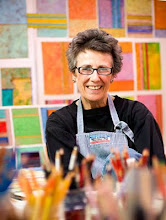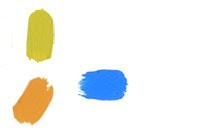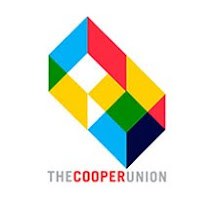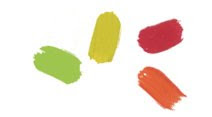Thursday, July 29, 2010
About the Aging Artist
I am an expert on this topic as I have some years of first hand experience. I am very attentive to how others have done it and encouraged by certain histories. Titian was said to have done his best work in his nineties. A dear friend that I have mentioned here before reached 93 painting with greater strength than ever. Willem DeKooning was deep into Alzheimer’s disease and painting well. William Utermohlen’s self portrait journaling of his descent into the same terrible illness is an incredible look from the inside. The self portraits become increasingly expressive as he is taken over by the illness.
Despite severe arthritis, Matisse worked from his wheelchair till age 81, and Monet continued painting into his 80's even with encroaching blindness. Georgia O’Keefe lost her eyesight and turned to pottery. And she hired a studio assistant to execute some of her ideas for paintings.
The aging artist’s brain ages as do most brains, but the part that paints seems to hang in pretty well. I found the following quote at: Creativity & Aging: Women Artists Aging Artfully
“while it is true there will be physical limitation that comes in very advanced age, creativity knows no boundaries; it is never too late to live expressively creative; and creativity allows for a life of successful aging and aging wellness at any age.”
I have to admit to some concern about this issue. I’m not finished with it yet.
The image above is Sunbow 18" x 36" Acrylic on Paper Adhered to Canvas ©2000 Joan Gold
Friday, July 23, 2010
About Change
A note from my nephew, Lorenzo, (The Alchemist's Pillow) caused me to think about what it is in us that resists change. It came to me that change brings a sense of loss.
Early on we form a picture of the world around us. The new experience that doesn’t conform to our perceived reality might mean forfeiting it. Readjusting the picture is usually unsettling, often disturbing, and at its worst, painful.
When we thought the earth was flat it was hard to conceive of taking a tour of the circumference without falling off. That was a hard one. I call to mind often the almost ninety years of my father’s life, begun on the cobblestone streets of Brooklyn, where his knee was injured when he was run over by a horse drawn wagon. He seemed to welcome the changes in his time and at the same time loved his history. Then I had an artist friend who died at 93; he railed against present day scientific knowledge after serving in World War Two. He saw advances in technology as destructive of life. It served no purpose to remind him that his life had been saved by modern medicine after a diagnosis of an aggressive form of cancer.
I have often wished I had never seen a painting so that I could envision something totally free of any notion of what a painting is and “should” look like. I find my self sometimes looking at something I have produced and asking: “Is this a painting?” Of course, in truth, I would not be a painter if I had never seen a painting. How then would I have known what I wanted to do?
To add your thoughts to mine, please use the comments area below. I am always interested in anyone's take on my ruminations.
The image above is Charity ©2010 Acrylic Collage Painting 17" x 11". For information or to purchase any of the paintings on this site, please email Joan.
Early on we form a picture of the world around us. The new experience that doesn’t conform to our perceived reality might mean forfeiting it. Readjusting the picture is usually unsettling, often disturbing, and at its worst, painful.
When we thought the earth was flat it was hard to conceive of taking a tour of the circumference without falling off. That was a hard one. I call to mind often the almost ninety years of my father’s life, begun on the cobblestone streets of Brooklyn, where his knee was injured when he was run over by a horse drawn wagon. He seemed to welcome the changes in his time and at the same time loved his history. Then I had an artist friend who died at 93; he railed against present day scientific knowledge after serving in World War Two. He saw advances in technology as destructive of life. It served no purpose to remind him that his life had been saved by modern medicine after a diagnosis of an aggressive form of cancer.
I have often wished I had never seen a painting so that I could envision something totally free of any notion of what a painting is and “should” look like. I find my self sometimes looking at something I have produced and asking: “Is this a painting?” Of course, in truth, I would not be a painter if I had never seen a painting. How then would I have known what I wanted to do?
To add your thoughts to mine, please use the comments area below. I am always interested in anyone's take on my ruminations.
The image above is Charity ©2010 Acrylic Collage Painting 17" x 11". For information or to purchase any of the paintings on this site, please email Joan.
Friday, July 16, 2010
About Modern Times
Some years ago, while in San Francisco, I was taken to visit a young man who worked for Apple. He was testing a color monitor long before these models were ready to market. To show me what was in our future, he called up a bright cerulean blue screen and drew a wide swathe of cadmium red light across it horizontally. I was enthralled. That was the kind of light I wanted in my paintings.
Now, many years later, I get to use this tool as I work. My printer cannot produce anything that rivals the luminosity before me on the screen, but the impulse to produce it is usually behind the work.
From The London Evening Standard: “Tate Britain has announced its first iPad art installation."
"It is believed to be the first time the Apple touchscreen computers have been used in a major gallery installation.
The move follows the work done by artists such as David Hockney, who has created a series of artworks using his iPad.”
There we have the computer as canvas. I imagine that Da Vinci would have liked these apples.
The image above is not a painting nor does it exist in any form other than a file on my computer (and now on yours). It will never look as good on any other surface.
Now, many years later, I get to use this tool as I work. My printer cannot produce anything that rivals the luminosity before me on the screen, but the impulse to produce it is usually behind the work.
From The London Evening Standard: “Tate Britain has announced its first iPad art installation."
"It is believed to be the first time the Apple touchscreen computers have been used in a major gallery installation.
The move follows the work done by artists such as David Hockney, who has created a series of artworks using his iPad.”
There we have the computer as canvas. I imagine that Da Vinci would have liked these apples.
The image above is not a painting nor does it exist in any form other than a file on my computer (and now on yours). It will never look as good on any other surface.
Friday, July 9, 2010
About Blogging
I don’t walk unless I want to get somewhere and I try (with limited success) not to speak unless I have something to say. Why then this commitment to writing something for an invisible audience every week? And why are so many of us doing this?
Wikipedia says: The personal blog, an ongoing diary or commentary by an individual, is the traditional, most common blog. Personal bloggers usually take pride in their blog posts, even if their blog is never read. Blogs often become more than a way to just communicate; they become a way to reflect on life, or works of art.
I require isolation for work and am fond of solitude and silence. But enough is enough. I want my paintings to be seen. Admired too, if I can make that happen. And sold is really nice. So the answer for me is that I do this blog out of necessity. I have found that I like doing it. Big surprise. Fortunately for me, as any of my friends and family can attest to, I am rarely at a loss for words.
There must be an endless variety of reasons for blogging, but basically it is just one. We want to have some kind of recognized presence in this world and to feel some sort of connectedness. That’s why we invented language, right?
My nephew Lorenzo (at The Alchemist’s Pillow) quoted the Portuguese poet Fernando Pessoa:
What could anyone confess that would be worth anything or serve any useful purpose? What has happened to us has either happened to everyone or to us alone; if the former it has no novelty value and if the latter it will be incomprehensible.
The image above is Portulaca ©2010, Giclée Print, size varies. For information or to purchase any of the paintings on this site, please email Joan.
Wikipedia says: The personal blog, an ongoing diary or commentary by an individual, is the traditional, most common blog. Personal bloggers usually take pride in their blog posts, even if their blog is never read. Blogs often become more than a way to just communicate; they become a way to reflect on life, or works of art.
I require isolation for work and am fond of solitude and silence. But enough is enough. I want my paintings to be seen. Admired too, if I can make that happen. And sold is really nice. So the answer for me is that I do this blog out of necessity. I have found that I like doing it. Big surprise. Fortunately for me, as any of my friends and family can attest to, I am rarely at a loss for words.
There must be an endless variety of reasons for blogging, but basically it is just one. We want to have some kind of recognized presence in this world and to feel some sort of connectedness. That’s why we invented language, right?
My nephew Lorenzo (at The Alchemist’s Pillow) quoted the Portuguese poet Fernando Pessoa:
What could anyone confess that would be worth anything or serve any useful purpose? What has happened to us has either happened to everyone or to us alone; if the former it has no novelty value and if the latter it will be incomprehensible.
The image above is Portulaca ©2010, Giclée Print, size varies. For information or to purchase any of the paintings on this site, please email Joan.
Friday, July 2, 2010
About the Method
This image is of my current unfinished project. The yellow orange rectangle was painted with acrylics on paper and later scanned. The red piece was painted, scanned, and then superimposed on the orange piece in Photoshop. Colors were tweaked a bit; these didn’t need much, and then the black areas, which are illustrations of French ironwork, were added to the mix. I move the blacks around to find the best placement, erasing parts and turning and repeating and enlarging, and flipping. I am, in effect, making a painting. This is a collage operation, far more malleable than anything I can do in the studio with the same materials pre-scanning. How often have I wished that a strip of painted paper were just a little bigger or a little greener or darker? Here I have the sorcery.
These giclées I make are not reproductions. There is no original. I don’t number them because there are very few that are alike. And there is no plate of metal or wood or stone or silk to print from that will deteriorate with use. I need to find a different name for them. Any suggestions?
Georgia O’Keeffe: I found I could say things with color and shapes that I couldn't say any other way — things I had no words for.
For information about any of the paintings on this site, please email Joan
These giclées I make are not reproductions. There is no original. I don’t number them because there are very few that are alike. And there is no plate of metal or wood or stone or silk to print from that will deteriorate with use. I need to find a different name for them. Any suggestions?
Georgia O’Keeffe: I found I could say things with color and shapes that I couldn't say any other way — things I had no words for.
For information about any of the paintings on this site, please email Joan
Subscribe to:
Posts (Atom)

















